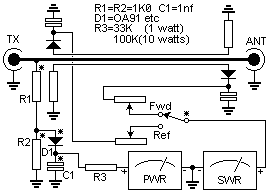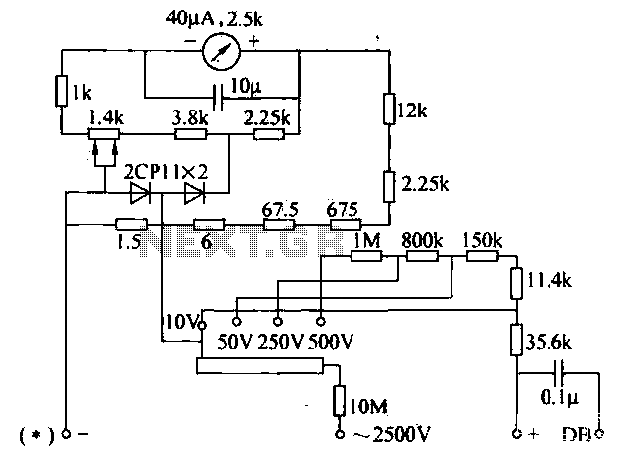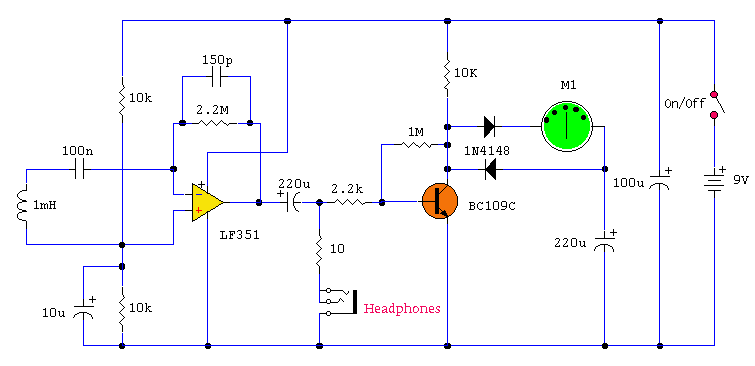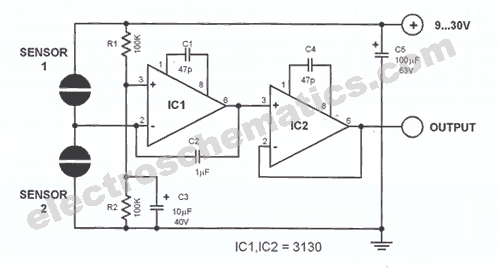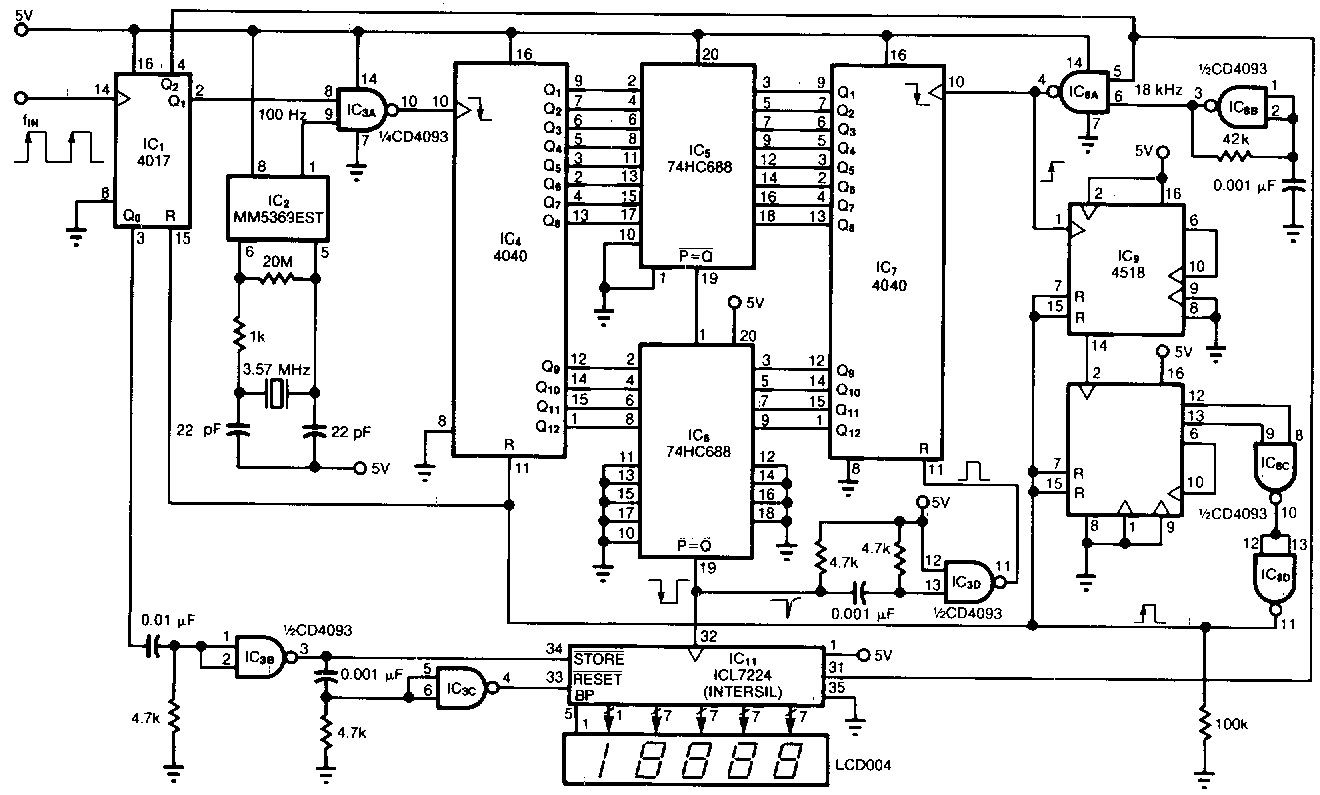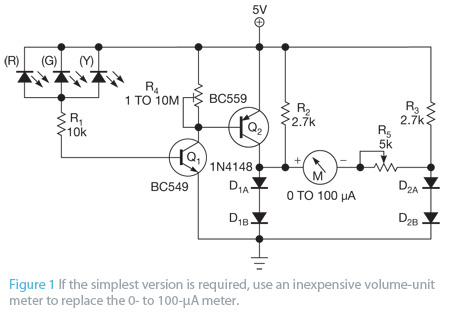
MilliGauss Meter
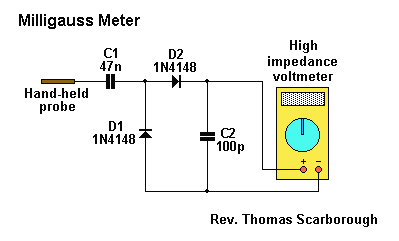
The circuit illustrated in Fig. 1 offers a straightforward and reliable method for detecting the intensity of alternating current (AC) or extremely low frequency (ELF) fields in residential or workplace environments. It is particularly effective as it not only identifies the electromagnetic radiation emitted by electrical devices but also measures the electromagnetic energy absorbed by the human body. The circuit in Fig. 1 functions as a standard charge pump, which is energized by the alternating eddy currents induced in the body by AC fields. Capacitor C1 charges almost instantaneously and can be measured using a digital voltmeter or a high-impedance voltmeter. To convert the millivolt reading to milligauss (the unit for magnetic field strength), one can divide the millivolt reading by four. For instance, a reading of 1000 mV corresponds to 250 milligauss. A general guideline for interpreting the readings indicates that detrimental effects have been noted at exposure levels as low as 3 milligauss. Numerous studies conducted since the 1970s have suggested that prolonged exposure to elevated ELF levels may increase the risk of certain cancers and miscarriages. Measurements are taken while the probe is held in one hand, and it is important to note that the highest reading does not necessarily occur at the closest distance to the electromagnetic source, likely due to the localization of induced currents within the body at short distances.
The circuit employs a charge pump topology, which is designed to convert the low-frequency AC signals present in the environment into a measurable DC voltage. This is achieved through the use of capacitive coupling, where the AC fields induce eddy currents within the conductive tissues of the human body. The induced currents generate a voltage across capacitor C1, which is then read by the voltmeter. The choice of components is critical for ensuring accuracy and responsiveness; thus, C1 should be selected based on its capacitance value and voltage rating, capable of handling the transient voltages generated during operation.
To enhance the circuit's performance, a high-impedance voltmeter is recommended to minimize loading effects, which could otherwise distort the readings. The circuit may also include a diode rectifier to ensure that the voltage across C1 is unidirectional, thus providing a steady DC output for measurement. The output from the circuit can be further processed or displayed using an analog or digital display for ease of interpretation.
When using this circuit for field intensity measurements, it is advisable to maintain a consistent methodology, such as holding the probe at a fixed distance from potential sources of electromagnetic fields. This practice helps in obtaining repeatable and comparable results. Additionally, the circuit can be adapted for use in various applications, including safety assessments in workplaces, residential areas, and proximity to high-voltage power lines, contributing to a better understanding of environmental exposure to electromagnetic fields.The circuit of Fig. 1 provides an easy yet reliable way to detect the intensity of a. c. (or e. l. f. ) fields around the home or workplace. It is doubly effective because it does not merely detect the electromagnetic radiation emitted by electrical appliances, but the electromagnetic energy actually absorbed by the body. The circuit in Fig. 1 is a stan dard charge pump which is charged by the alternating eddy currents induced in the human body by a. c. fields. C1 charges virtually instantly, and is read by a digital (or high impedance) voltmeter. To obtain a very rough translation from millivolts to milligauss (the unit of magnetic field strength), divide the mill volts reading by four. For example, 1000mV will yield 250 mill gauss. A rough guide to the readings follows: Detrimental effects have been reported at doses as low as 3 milligauss, and a series of studies since the 1970`s has shown that sustained exposure to high e.
l. f. doses heightens the risk of certain cancers and miscarriage. Readings are taken while holding the probe in one hand. The closest proximity to the electromagnetic source does not necessarily give the highest reading, probably because the induced currents in the body remain localised at close proximity. 🔗 External reference
The circuit employs a charge pump topology, which is designed to convert the low-frequency AC signals present in the environment into a measurable DC voltage. This is achieved through the use of capacitive coupling, where the AC fields induce eddy currents within the conductive tissues of the human body. The induced currents generate a voltage across capacitor C1, which is then read by the voltmeter. The choice of components is critical for ensuring accuracy and responsiveness; thus, C1 should be selected based on its capacitance value and voltage rating, capable of handling the transient voltages generated during operation.
To enhance the circuit's performance, a high-impedance voltmeter is recommended to minimize loading effects, which could otherwise distort the readings. The circuit may also include a diode rectifier to ensure that the voltage across C1 is unidirectional, thus providing a steady DC output for measurement. The output from the circuit can be further processed or displayed using an analog or digital display for ease of interpretation.
When using this circuit for field intensity measurements, it is advisable to maintain a consistent methodology, such as holding the probe at a fixed distance from potential sources of electromagnetic fields. This practice helps in obtaining repeatable and comparable results. Additionally, the circuit can be adapted for use in various applications, including safety assessments in workplaces, residential areas, and proximity to high-voltage power lines, contributing to a better understanding of environmental exposure to electromagnetic fields.The circuit of Fig. 1 provides an easy yet reliable way to detect the intensity of a. c. (or e. l. f. ) fields around the home or workplace. It is doubly effective because it does not merely detect the electromagnetic radiation emitted by electrical appliances, but the electromagnetic energy actually absorbed by the body. The circuit in Fig. 1 is a stan dard charge pump which is charged by the alternating eddy currents induced in the human body by a. c. fields. C1 charges virtually instantly, and is read by a digital (or high impedance) voltmeter. To obtain a very rough translation from millivolts to milligauss (the unit of magnetic field strength), divide the mill volts reading by four. For example, 1000mV will yield 250 mill gauss. A rough guide to the readings follows: Detrimental effects have been reported at doses as low as 3 milligauss, and a series of studies since the 1970`s has shown that sustained exposure to high e.
l. f. doses heightens the risk of certain cancers and miscarriage. Readings are taken while holding the probe in one hand. The closest proximity to the electromagnetic source does not necessarily give the highest reading, probably because the induced currents in the body remain localised at close proximity. 🔗 External reference
